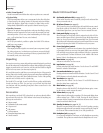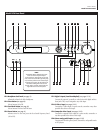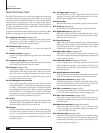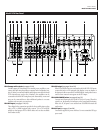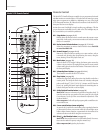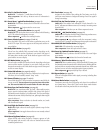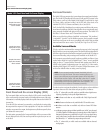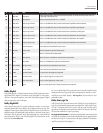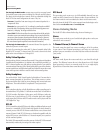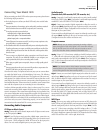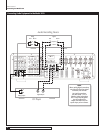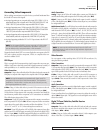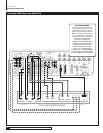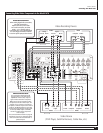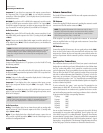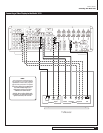
14
Outlaw Audio
Owner’s Manual
The Pro Logic IIx Music mode
converts stereo music into surround sound.
Use it with any stereo music source, including CDs, FM radio, and MP3 players.
The Music mode includes three controls, which are adjustable through the
Model 1070's Surround Configuration sub-menu: They are:
Panorama:
Extends the front stereo image to the surround speakers for a
“wraparound” effect.
Dimension:
Lets you correct for “dry” recordings by extending the soundfield
towards the back of the listening/viewing area and to decrease apparent rever-
beration by “collapsing” the image towards the front.
Center Width:
This blends sound from the center channel into the left and right
channels to create a more seamless front soundstage. You can vary the effect from
one extreme (where the center channel speaker is shut off and only a “phantom”
signal derived from the left and right speakers remains) to the other (where only
the center channel speaker reproduces center channel information.)
The Pro Logic IIx Game mode
sends surround channel bass signals to the
subwoofer to preserve visceral impact.
Pro Logic IIx processing also works with 5.1-channel material, either Dolby
Digital or DTS, to create 7.1-channel sound. This mode is shown in the front
panel and on-screen displays as “ProLogicIIx-X
Dolby Virtual Speaker
Strictly speaking, this isn’t a surround format at all. Using advanced algorithms
(mathematical manipulations), it duplicates the sound field generated by a
full 5.1-channel speaker array with just two speakers placed as you would for
conventional stereo listening. Dolby Virtual Speaker delivers precise localization,
accurate spatial clues, and high sound quality and is ideal for anyone who wants
a surround experience without a center channel and surround speakers.
Dolby Headphone
You could call this “Dolby Virtual Speaker for Headphones” because that’s a
pretty accurate description of what it does. This circuitry creates a convinc-
ing surround effect that’s ideal for private listening with conventional stereo
headphones. The math behind it is complicated. The enjoyment isn’t.
DTS
This is a similar technology to Dolby Digital but uses a higher sampling rate. In
its standard form, DTS provides 5.1-channel surround sound. It is available on
CD, DVD, laserdiscs, PlayStation 2 video games, and D-VHS tapes. Audio-only
DTS discs may be used with any CD, DVD, or laserdisc player with a digital
audio output, but DVD discs with DTS audio must be used on players with the
“DTS Digital Out” logo.
DTS-ES
DTS-ES extends the original DTS format by adding an additional back surround
channel to a soundtrack. DTS-ES-Matrix titles provide the sixth channel by
a matrix process, while DTS-ES-Discrete media delivers a true, discrete back
surround channel. Both DTS-ES formats are backward compatible with the
original DTS process, and will deliver a 5.1-channel output if your system has
no back surround speakers.
The Model 1070 automatically senses the presence of either DTS-ES format and
automatically switches the processing mode when required.
DTS Neo:6
This processing mode creates up to six full-bandwidth channels from any
matrix-encoded 2-channel source. It offers two modes, Cinema and Music. Use
the Cinema mode for movie soundtracks, the Music mode for stereo music.
More info about the Model 1070’s various surround-sound technologies can be
found at the
www.dtsonline.com
and
www.dolby.com
.
Stereo Listening Modes
The Model 1070 offers advanced technology for stereo listening, too.
Stereo
This mode routes sound only to your front left and right speakers–and to your
subwoofer if one is connected.
7-Channel Stereo/5-Channel Stereo
This mode routes the signal from a stereo recording to all of the speakers
in your system. There’s minimal processing so you’ll enjoy very even sound
quality as you move around the room–that’s why these modes are often called
“party modes.”
Bypass
Like Stereo mode, Bypass also routes sound only to your front left and right
speakers. The difference between the two is that Bypass has no DSP (digital
signal processing), so there’s no surround modes, etc. As you might expect,
Bypass delivers a somewhat cleaner sound than Stereo mode.
Stereo Listening Modes



